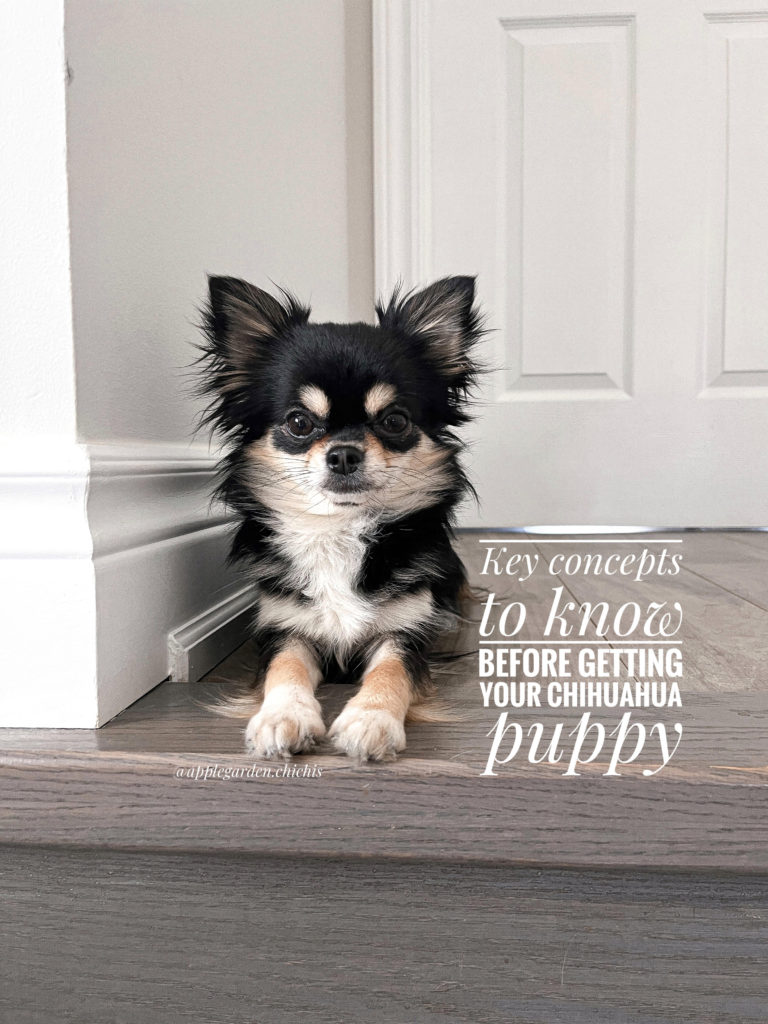️
There are several initial concepts I want every chihuahua owner to know before bringing a puppy home.
They aren’t complicated and will help explain some of the dog behaviors.
Puppy area – minimize initial stress by setting up the area the for the first week the same way as it was at a breeder’s home. It gives feeling of safety and the puppy knows where to find a bed and a potty area. It will let puppy to focus on exploring the new home and connecting with owners. Once settled, the set up can be removed or rearranged to your preference.
Hypoglycemia – low blood sugar can affect pups under 8 months old. A puppy may have pale gums, be wobbly, vomit or be unusually disengaged. In severe cases it may be weak, unable to stand up, unconscious or have seizure episodes. Puppies need to be monitored – once they are actively playing they forget of bodily functions until it is too late.
 Pause a game/walk or other activity every 15 mins for a young pup and every 30 mins for an older pup to relax.
Pause a game/walk or other activity every 15 mins for a young pup and every 30 mins for an older pup to relax.
 Have a puppy in a crate/playpen with no distractions for 10-15 mins. Offer food and water.
Have a puppy in a crate/playpen with no distractions for 10-15 mins. Offer food and water.
 If you suspect hypoglycemia – feed some food as soon as possible or give a little bit of Nutri-Cal. Go to a vet if concerned.
If you suspect hypoglycemia – feed some food as soon as possible or give a little bit of Nutri-Cal. Go to a vet if concerned.
Note: emotional overwhelming and stress can trigger low blood sugar, not only physical exercise.
Potty breaks – even if a puppy is reliably potty trained, if it’s engaged in a game, you may see it potty right where it is, as the initial body signals were missed. No reason to scold the puppy – at this period of life it is the owner’s fault as we are the ones to set our puppies for success. Puppies tend to potty about 20 mins after being fed – walk them after feeding and do several breaks in between an activity (including sleeping on the couch – yes, they will be so cozy with you they’ll forget to go pee and do it on the couch which will frustrate you).
No Stairs Rule – for correct bone development it is highly suggested not to allow the puppy to use stairs of any kind up until at least 6 months old. To avoid back issues in your puppy when it gets older put gates for the first 6 months to 1 year. As tough as it sounds now, the dog that lives to 15 years old will have a solid bone structure thanks to your responsible approach early on in its life.
Socialization – keep sessions up to 20 mins – go outside and let the puppy observe surroundings. If it doesn’t want to approach other people and dogs, that’s okay, help build confidence in the environment slowly. Be conscious not to overwhelm with multitude of novelties at once – introduce gradually and gauge by the pup’s response. Sign up for group puppy training and socialization class to help introduce new things in a safe controlled environment. Visiting public dog parks is highly not recommended due to common misbehaviours and unknown health issues in other dogs – only socialize with trusted dogs/animals. Be there for your pup to earn their trust and confidence in you.
Watch your steps – many people worry to step on a puppy and so start walking unnaturally at home. I suggest to teach your puppy to think and analyze the situation themselves to help build self-reliance at home prior to going to a crowded outside area. For the first several weeks continue the same routine just move in a bit slow motion. Let the pup bump into your feet to learn to avoid foot traffic. Eventually, they will be able to predict your steps and be ready to use this thought process on a busy street.
Gum massage – from day one start lifting their lips, opening mouth and massaging the gums. When ready, start brushing front teeth first, then gradually lengthen the process. You may use a Qtip first and then transition to a tooth brush. An enzymatic based tooth paste is best to remove any plaque.
Nail Trim – start touching the pads from day one to accustom to the sensation. Once comfortable, use a nail clipper to trim a couple of nails – release and give treats. You don’t have to do all 4 paws at once, do as many as you feel comfortable. Puppies are like little kids, they don’t have much patience for boring things – just do it consistently and the puppy will learn the expectations and will let you calmly do all the paws.
Remember to give lots of treats and praise at every training session. Make the process fun and engaging for both you and the puppy!
For a list of items recommended to have for your puppy, check out this blog post: CHECKLIST: PREPARING FOR A NEW PUPPY
#applegardenchihuahuasblog



